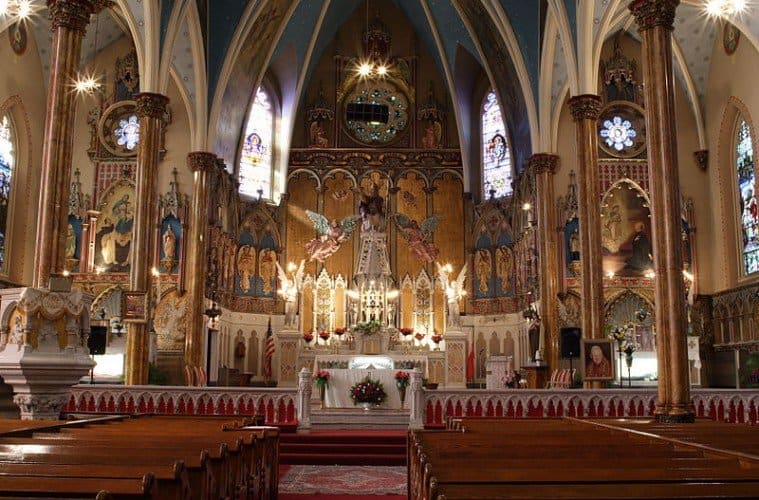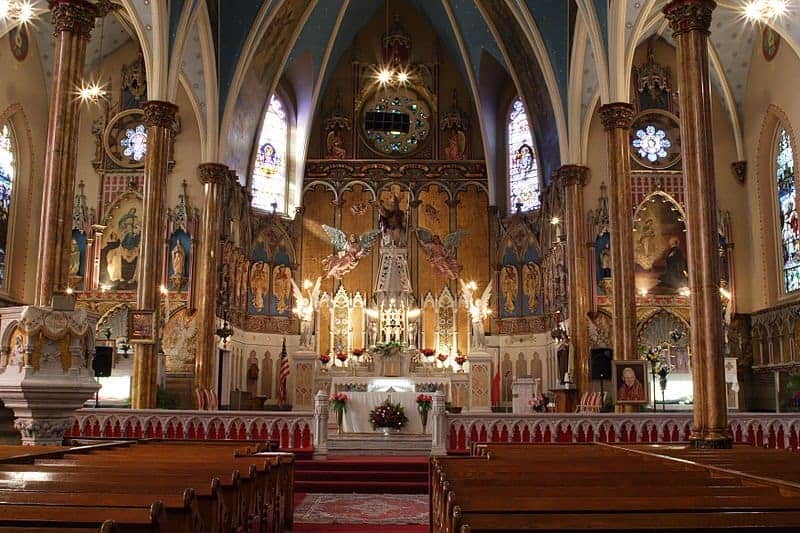Mass Mobs. Have you heard of these? Around the country, in older cities with pronounced Catholic fingerprints like Detroit and New York, Catholics are flocking in large numbers to Sunday Masses at urban churches to draw attention to forgotten historic buildings. These churches are now in rougher parts of cities that were once, a long time ago, vibrant centers of Catholic immigrant communities. Most often, these immigrants were poor, but they spared no expense in cobbling together whatever resources they had to build beautiful houses of worship. The years rolled on. The immigrants grew older and their kids and grandkids went to college, found a nice job, got married, packed their bags and moved, either out of state or into the safer, quieter and more spacious suburbs. The old church buildings where they were baptized were largely abandoned, left with loyal, but severely dwindling numbers of aging or ethnic parishioners. Most of these neighborhoods simultaneously entered into a downward spiral of poverty, neglect and crime. Often, as you drive through these rough parts of older cities, you’ll see soaring steeples amidst litter-strewn streets, boarded up houses and abandoned shops. More often than not, it’s a Catholic church. (In Milwaukee, Saint Michael’s on Vliet comes to mind.) Do some research and you’ll discover that, one-hundred years ago, this was where the Germans came and set up shop, or maybe the Italians in another part of town. The local bakery was thataway, just down the block. The diner and cafe? Take a left at the corner and you’re there. The hardware store? Just half a block from the candy store. Now, they’re gone. But the churches, in many cities, are still standing.
If you’re fortunate to find such a church unlocked (good luck with that) you’ll be stunned by what you see inside: exquisitely carved high altars and baptismal fonts, chiseled marble communion rails, elaborate stained-glass windows, soaring, vaulted ceilings, dozens of statues looking down on you from various niches. Look closer and you’ll probably notice a lot of chipping, flaking, cracks and water stains. As always, time takes its toll. But the beauty remains. Declining parishioners translate into less money for upkeep. The good news is that, in this age of restoration and fixer-upers, some Catholics in the U.S. are hoping to reverse the trend by rediscovering and reinvigorating the architectural treasures left by their ancestors. Enter the Mass Mob.
If there’s one thing social media does very well, it’s mobilize people across a large area on short notice. So, for the Mass Mob movement, an urban, largely forgotten parish is selected and a challenge is issued on social media to local Catholics to show up en masse for Mass on a particular Sunday, no matter what their regular parish may be. The results have been remarkably positive. Catholics from the city and the suburbs flock to a forgotten parish for Mass to show their love and appreciation for a landmark building. It’s a win-win situation: collections rake in badly needed funds to support critical repair work and, in return, suburban Catholics accustomed to bland, squeaky clean, minimalist suburban churches get a sensory overload. Many who have lived in these cities for their whole lives are shocked that they’d never seen the interiors of these sublime buildings before.
Could we pull off a Mass Mob in Milwaukee? We have no shortage of churches that could use some attention. What parishes come to mind? I mentioned Saint Michael’s on 2414 W. Vliet earlier. Some others: Saint Casimir (2600 N. Bremen), Our Lady of Guadalupe/Saint Patrick (613 S. 4th Street), Saint George Melkite Church (1617 W. State Street), or Saints Peter and Paul (2490 N. Cramer Street). Any other suggestions?



